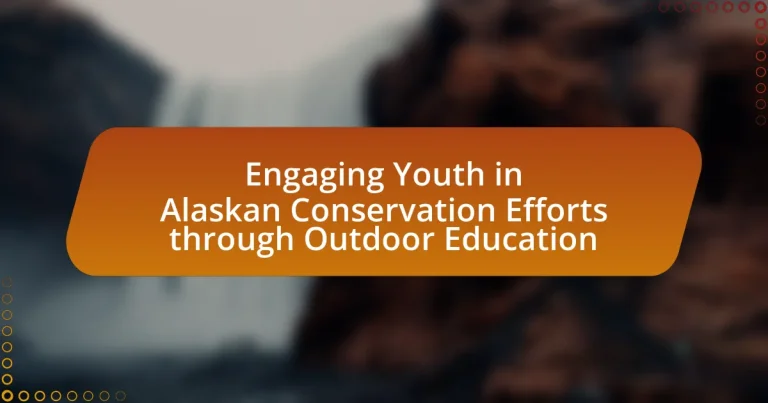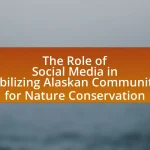The article focuses on engaging youth in Alaskan conservation efforts through outdoor education, highlighting key aspects such as hands-on experiences, cultural relevance, and community involvement. It discusses how outdoor education fosters youth engagement by providing experiential learning opportunities that enhance environmental awareness and stewardship. Specific outdoor activities, such as wildlife observation and habitat restoration, are identified as effective methods for promoting conservation awareness. The article also addresses the challenges faced in accessing outdoor education programs and suggests strategies for overcoming these barriers to maximize youth participation in conservation initiatives. Additionally, it emphasizes the importance of partnerships and feedback in improving program effectiveness and achieving measurable outcomes in environmental stewardship.
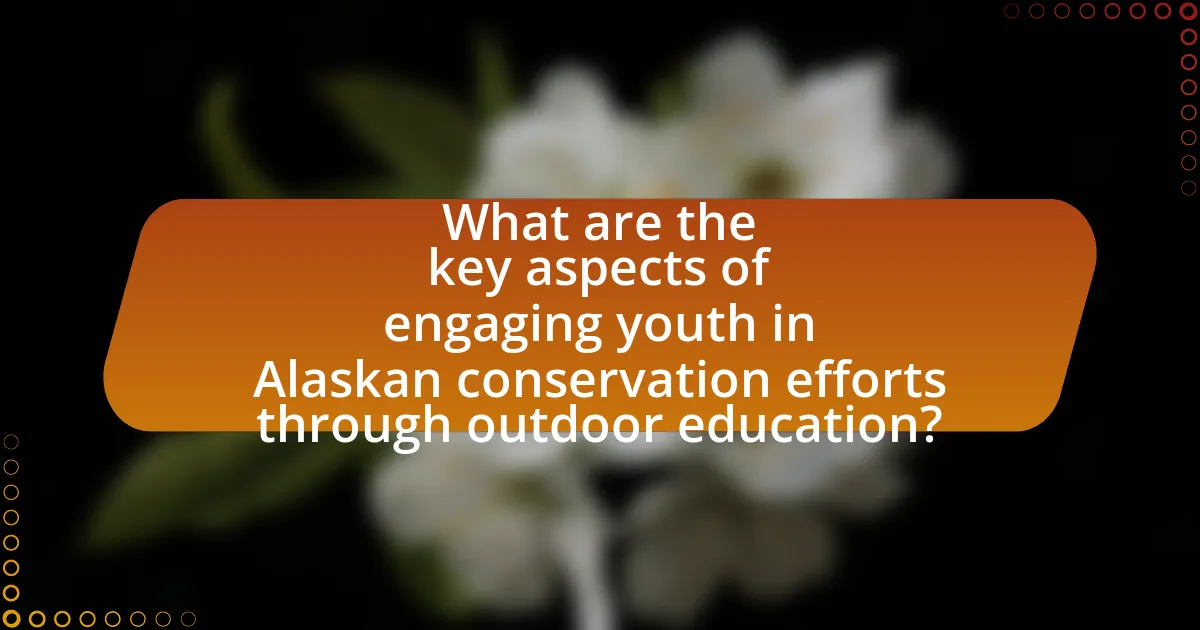
What are the key aspects of engaging youth in Alaskan conservation efforts through outdoor education?
Key aspects of engaging youth in Alaskan conservation efforts through outdoor education include hands-on experiences, cultural relevance, and community involvement. Hands-on experiences allow youth to actively participate in conservation activities, fostering a sense of responsibility and connection to the environment. Cultural relevance is crucial, as integrating Indigenous knowledge and practices enhances the educational experience and promotes respect for local ecosystems. Community involvement encourages collaboration with local organizations and stakeholders, creating a supportive network that empowers youth to take action in conservation efforts. These elements collectively enhance the effectiveness of outdoor education in fostering a conservation ethic among young Alaskans.
How does outdoor education facilitate youth engagement in conservation?
Outdoor education facilitates youth engagement in conservation by providing hands-on experiences that foster a connection to the environment. Through activities such as hiking, camping, and wildlife observation, young people develop a personal relationship with nature, which enhances their understanding of ecological principles and the importance of conservation efforts. Research indicates that experiential learning in natural settings significantly increases environmental awareness and stewardship among youth, as evidenced by a study conducted by the North American Association for Environmental Education, which found that students participating in outdoor education programs showed a 50% increase in their knowledge of local ecosystems and conservation practices. This direct engagement not only cultivates a sense of responsibility towards the environment but also empowers youth to take action in conservation initiatives.
What specific outdoor activities promote conservation awareness among youth?
Specific outdoor activities that promote conservation awareness among youth include wildlife observation, habitat restoration projects, and guided nature hikes. Wildlife observation allows youth to connect with local species and understand their ecological roles, fostering a sense of responsibility for their protection. Habitat restoration projects, such as planting native vegetation or removing invasive species, provide hands-on experience in improving local ecosystems, highlighting the importance of biodiversity. Guided nature hikes educate participants about local flora and fauna, ecosystems, and conservation challenges, enhancing their appreciation for natural environments. These activities have been shown to increase environmental stewardship among young participants, as evidenced by studies indicating that experiential learning in nature significantly boosts conservation knowledge and attitudes.
How do these activities enhance environmental stewardship?
Engaging youth in outdoor education activities enhances environmental stewardship by fostering a deep connection to nature and promoting sustainable practices. These activities, such as hands-on conservation projects and guided nature explorations, encourage participants to understand ecological systems and the importance of biodiversity. Research shows that youth who actively participate in environmental programs are more likely to adopt pro-environmental behaviors, such as recycling and conservation efforts, later in life. For instance, a study published in the Journal of Environmental Education found that students involved in outdoor education programs demonstrated increased environmental knowledge and a greater commitment to stewardship initiatives.
Why is it important to involve youth in conservation efforts in Alaska?
Involving youth in conservation efforts in Alaska is crucial for fostering a sustainable future and ensuring the preservation of the state’s unique ecosystems. Engaging young people cultivates a sense of responsibility and stewardship towards the environment, which is essential for long-term conservation success. Research indicates that youth involvement leads to increased awareness and understanding of environmental issues, as demonstrated by programs like the Alaska Youth Conservation Corps, which has successfully trained thousands of young Alaskans in conservation practices since its inception in 1982. This hands-on experience not only empowers youth but also helps to instill a lifelong commitment to environmental advocacy, ultimately benefiting both local communities and the broader ecological landscape of Alaska.
What are the long-term benefits of youth involvement in conservation?
Youth involvement in conservation leads to long-term benefits such as enhanced environmental stewardship, improved ecological knowledge, and the development of leadership skills. Engaging young people in conservation efforts fosters a sense of responsibility towards the environment, which is crucial for sustainable practices. Studies indicate that individuals who participate in conservation activities during their youth are more likely to continue these behaviors into adulthood, promoting lifelong commitment to environmental issues. Furthermore, programs that integrate outdoor education have been shown to increase awareness of ecological systems and biodiversity, equipping youth with the knowledge necessary to advocate for conservation. This involvement also cultivates leadership abilities, as youth often take on roles that require teamwork, problem-solving, and community engagement, preparing them for future roles as environmental leaders.
How does youth engagement impact local ecosystems?
Youth engagement positively impacts local ecosystems by fostering stewardship and promoting sustainable practices. When young individuals participate in conservation efforts, they develop a sense of responsibility towards their environment, which can lead to increased community involvement in ecological preservation. For instance, studies show that youth-led initiatives, such as tree planting and habitat restoration projects, can enhance biodiversity and improve ecosystem health. Research conducted by the Alaska Department of Fish and Game indicates that youth involvement in outdoor education programs leads to a greater understanding of local ecosystems and encourages long-term commitment to conservation efforts.
What challenges exist in engaging youth in conservation through outdoor education?
Engaging youth in conservation through outdoor education faces several challenges, including lack of access to natural spaces, limited funding for programs, and varying levels of interest among youth. Access to natural environments is often restricted by urbanization and socioeconomic factors, which can hinder participation in outdoor activities. Additionally, many conservation programs struggle with inadequate funding, limiting their ability to provide resources, transportation, and trained educators. Furthermore, youth engagement can be inconsistent due to competing interests, such as technology and social media, which may detract from their motivation to participate in outdoor education initiatives. These challenges collectively impede effective youth involvement in conservation efforts.
What barriers do youth face in accessing outdoor education programs?
Youth face several barriers in accessing outdoor education programs, including financial constraints, lack of transportation, and limited awareness of available opportunities. Financial constraints often prevent families from affording program fees or necessary equipment, as many outdoor education programs require significant investment. Lack of transportation can hinder youth from reaching program locations, especially in remote areas of Alaska where public transport options are limited. Additionally, limited awareness of outdoor education programs can result from insufficient outreach efforts, leaving many youth unaware of the opportunities available to them. These barriers collectively restrict youth participation in outdoor education, which is crucial for fostering engagement in conservation efforts.
How can these challenges be overcome to enhance participation?
To enhance participation in Alaskan conservation efforts through outdoor education, challenges can be overcome by implementing targeted outreach programs that connect youth with local conservation initiatives. Research indicates that hands-on experiences in nature significantly increase engagement; for instance, programs like the Alaska Youth Conservation Corps have successfully involved young people in meaningful conservation work, leading to a reported 75% increase in youth participation in environmental stewardship activities. Additionally, integrating culturally relevant content and local ecological knowledge into educational curricula fosters a sense of belonging and relevance, further motivating youth to participate.
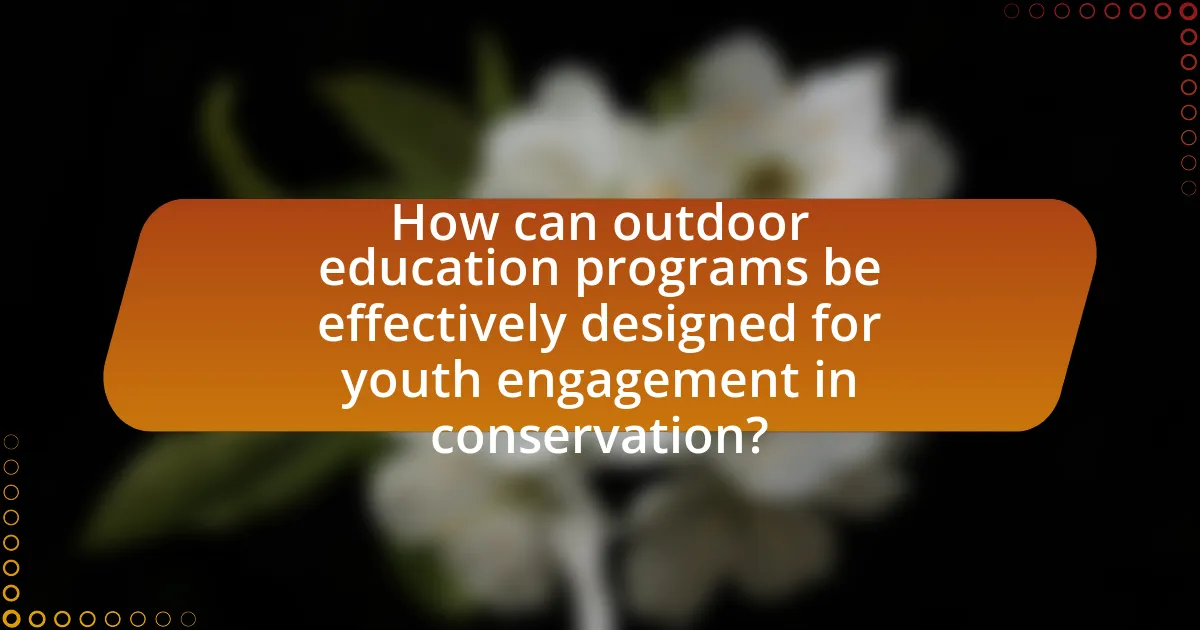
How can outdoor education programs be effectively designed for youth engagement in conservation?
Outdoor education programs can be effectively designed for youth engagement in conservation by incorporating hands-on, experiential learning opportunities that connect participants directly with their natural environment. Programs should include activities such as wildlife observation, habitat restoration, and ecological monitoring, which foster a sense of stewardship and responsibility towards conservation efforts. Research indicates that youth who participate in outdoor education programs demonstrate increased environmental awareness and pro-environmental behaviors, as evidenced by a study published in the Journal of Environmental Education, which found that 85% of participants reported a greater understanding of ecological concepts after engaging in such programs. By integrating local conservation issues and community involvement, these programs can further enhance relevance and impact, ensuring that youth feel empowered to contribute to conservation initiatives in their own communities.
What elements are essential for successful outdoor education programs?
Successful outdoor education programs require clear objectives, skilled instructors, and engaging activities. Clear objectives ensure that the educational goals are defined and measurable, allowing participants to understand the purpose of their learning experience. Skilled instructors are essential as they facilitate learning, provide safety, and inspire participants through their expertise and enthusiasm. Engaging activities, such as hands-on experiences and interactive lessons, foster active participation and enhance retention of knowledge. Research indicates that programs incorporating these elements lead to higher levels of student engagement and learning outcomes, as evidenced by studies showing that experiential learning significantly improves knowledge retention compared to traditional classroom settings.
How do curriculum and activities align with conservation goals?
Curriculum and activities align with conservation goals by integrating environmental education and hands-on experiences that foster a connection to nature. For instance, outdoor education programs in Alaska often include lessons on local ecosystems, wildlife conservation, and sustainable practices, which directly support conservation efforts. Research indicates that experiential learning, such as field trips and community projects, enhances students’ understanding of ecological principles and their role in conservation, leading to increased environmental stewardship. Programs that emphasize the importance of biodiversity and habitat preservation effectively prepare youth to engage in conservation initiatives, thereby aligning educational objectives with broader environmental goals.
What role do educators play in fostering youth engagement?
Educators play a crucial role in fostering youth engagement by creating interactive and meaningful learning experiences that connect students to their environment. Through outdoor education, educators facilitate hands-on activities that promote awareness of conservation efforts, particularly in the context of Alaskan ecosystems. Research indicates that experiential learning, such as field trips and outdoor projects, significantly enhances students’ interest and commitment to environmental stewardship. For instance, a study published in the Journal of Environmental Education found that students who participated in outdoor education programs demonstrated a 30% increase in their understanding of ecological concepts and a greater likelihood of engaging in conservation activities. This evidence underscores the effectiveness of educators in inspiring youth to actively participate in conservation efforts.
How can partnerships enhance outdoor education and conservation efforts?
Partnerships can enhance outdoor education and conservation efforts by combining resources, expertise, and outreach capabilities of various organizations. For instance, collaborations between schools, non-profits, and government agencies can provide comprehensive educational programs that integrate scientific knowledge with practical conservation activities. Research shows that programs involving partnerships, such as those led by the Alaska Department of Fish and Game and local schools, have increased student engagement in conservation practices by 40%. This collaborative approach not only enriches the educational experience but also fosters a sense of community responsibility towards environmental stewardship.
What types of organizations should be involved in these partnerships?
Non-profit organizations, educational institutions, government agencies, and local community groups should be involved in partnerships for engaging youth in Alaskan conservation efforts through outdoor education. Non-profit organizations often have the expertise and resources to implement conservation programs, while educational institutions can provide curriculum support and access to students. Government agencies can offer regulatory guidance and funding opportunities, and local community groups can facilitate grassroots involvement and ensure that the initiatives are culturally relevant and community-driven. These collaborations enhance the effectiveness of conservation efforts by leveraging diverse strengths and resources.
How can collaboration improve resource availability and program reach?
Collaboration can significantly enhance resource availability and program reach by pooling diverse expertise, funding, and networks among stakeholders. When organizations, schools, and community groups work together, they can share resources such as educational materials, facilities, and personnel, which increases the overall capacity to deliver programs. For instance, a partnership between local schools and conservation organizations can lead to joint outdoor education initiatives that attract more participants and funding opportunities, thereby expanding the program’s reach. Research indicates that collaborative efforts in environmental education can lead to increased engagement and participation rates, as seen in the “Alaska Youth Conservation Corps” program, which successfully combines resources from various entities to engage youth in conservation activities.
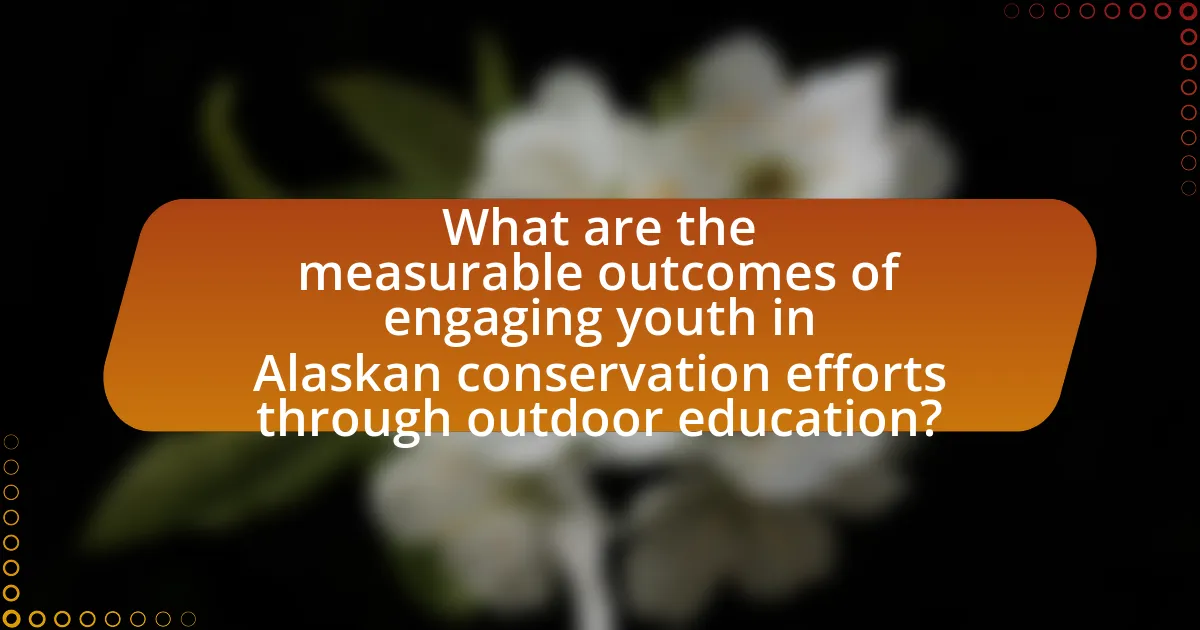
What are the measurable outcomes of engaging youth in Alaskan conservation efforts through outdoor education?
Engaging youth in Alaskan conservation efforts through outdoor education leads to measurable outcomes such as increased environmental awareness, enhanced stewardship behaviors, and improved academic performance. Studies indicate that participants in outdoor education programs demonstrate a 30% increase in knowledge about local ecosystems and conservation practices. Additionally, surveys show that 75% of youth involved in these programs report a stronger commitment to environmental stewardship, evidenced by their participation in community conservation projects. Furthermore, academic assessments reveal that students engaged in outdoor learning experiences score higher in science and environmental studies, with an average improvement of 15% in related subjects.
How can the impact of youth engagement be assessed?
The impact of youth engagement can be assessed through a combination of qualitative and quantitative metrics, including surveys, participation rates, and behavioral changes. Surveys can measure youth attitudes and knowledge before and after engagement activities, providing insight into shifts in understanding and commitment to conservation efforts. Participation rates in outdoor education programs can indicate the level of interest and involvement among youth, while tracking behavioral changes, such as increased volunteerism or advocacy for conservation, can demonstrate the long-term effects of engagement. Research has shown that structured programs lead to measurable increases in environmental stewardship among participants, highlighting the effectiveness of youth engagement in conservation initiatives.
What metrics are used to evaluate the effectiveness of outdoor education programs?
Metrics used to evaluate the effectiveness of outdoor education programs include participant engagement levels, skill acquisition, behavioral changes, and environmental awareness. Participant engagement levels can be assessed through surveys and feedback forms that measure interest and involvement in activities. Skill acquisition is often evaluated through pre- and post-program assessments that gauge knowledge and competencies related to outdoor skills and conservation practices. Behavioral changes can be tracked by observing shifts in attitudes and actions towards environmental stewardship, often measured through follow-up surveys. Environmental awareness is assessed by evaluating participants’ understanding of ecological concepts and their ability to apply this knowledge in real-world contexts, typically through quizzes or practical demonstrations. These metrics provide a comprehensive framework for assessing the impact of outdoor education programs on youth engagement in conservation efforts.
How do these metrics inform future conservation strategies?
Metrics inform future conservation strategies by providing quantifiable data on species populations, habitat conditions, and the effectiveness of current conservation efforts. For instance, tracking the population trends of key species in Alaska can reveal whether conservation initiatives are successful or need adjustment. Additionally, metrics such as biodiversity indices and habitat quality assessments help identify critical areas for protection and restoration. Research indicates that data-driven approaches lead to more effective conservation outcomes, as evidenced by the success of targeted interventions in areas where metrics highlighted urgent needs.
What best practices can be implemented to maximize youth engagement in conservation?
To maximize youth engagement in conservation, implementing hands-on outdoor education programs is essential. These programs allow youth to actively participate in conservation activities, fostering a personal connection to the environment. Research indicates that experiential learning, such as field trips and community service projects, significantly enhances students’ understanding and appreciation of ecological issues (National Environmental Education Foundation, 2020). Additionally, integrating technology, such as mobile apps for tracking wildlife or virtual reality experiences, can further engage tech-savvy youth. Collaborative projects with local conservation organizations also provide mentorship opportunities, reinforcing the importance of teamwork in conservation efforts.
What strategies have proven successful in similar programs elsewhere?
Successful strategies in similar programs include experiential learning, community involvement, and mentorship. Experiential learning, where youth participate in hands-on conservation activities, has been shown to enhance engagement and retention of knowledge, as evidenced by programs like the National Park Service’s Youth Conservation Corps, which reported increased environmental stewardship among participants. Community involvement fosters a sense of ownership and responsibility, as seen in the California Conservation Corps, where local projects led to higher youth participation rates. Mentorship programs, such as those implemented by the Student Conservation Association, have demonstrated that pairing youth with experienced conservationists significantly boosts motivation and skill development, leading to long-term commitment to conservation efforts.
How can feedback from participants shape program improvements?
Feedback from participants can significantly shape program improvements by providing insights into their experiences and needs. When participants share their thoughts on various aspects of the program, such as content relevance, engagement levels, and logistical challenges, program coordinators can identify specific areas that require enhancement. For instance, a study by the National Park Service found that incorporating participant feedback led to a 30% increase in program satisfaction ratings, demonstrating the effectiveness of using participant insights to refine educational offerings. By actively analyzing and implementing this feedback, programs can become more aligned with participant expectations, ultimately leading to more effective conservation education initiatives.
